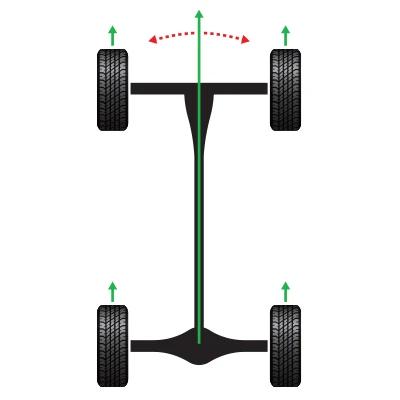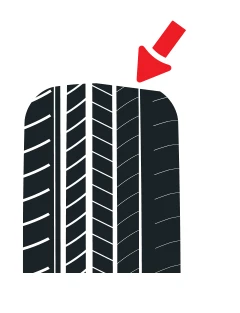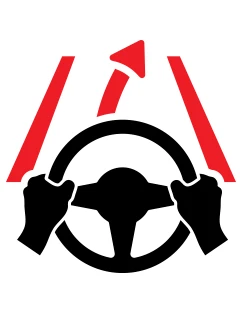What’s the Difference Between a Two-Wheel and Four-Wheel Alignment?
Every trip to the store, highway adventure, and dirt road expedition can cause your car or truck to go out of alignment. It’s just part of owning a vehicle. What’s the big deal? Misaligned tire and wheel assemblies can impact your fuel and range efficiency, cause tires to wear out a lot faster, and reduce overall drivability and safety. Let’s look at the differences between a two-wheel alignment and a four-wheel alignment and which one is right for your ride.
What is a Two-Wheel Alignment?
Also called a thrust angle alignment or a front-end alignment, a two-wheel alignment is for larger trucks and some SUVs with solid rear axles. This means only their front ends can be adjusted.
During a thrust-angle alignment, the front suspension and steering, as well as the camber, caster, toe, and thrust angle may be adjusted to bring your vehicle into alignment.
Trust Les Schwab to get your thrust angle alignment done right the first time.

What is a Four-Wheel Alignment?
Four-wheel alignments are needed on most of today’s front-wheel drive, all-wheel drive, passenger cars, SUVs, and crossover vehicles. A four-wheel alignment adjusts the front suspension and steering, as well as the rear suspension and steering (if needed), of your vehicle. These alignments may include the camber, caster, and toe on all four of the tire and wheel assemblies.
Once your vehicle has gone through a four-wheel alignment, and as long as there aren’t other unresolved issues with your suspension, you’ll notice your steering wheel is centered, your vehicle won’t pull to the right or left, and you have an easier time driving. Plus, you’ll save money on fuel and recharging and help your tires last longer.
At Les Schwab, we’re happy to give your alignment a free visual inspection. If it needs an adjustment, we’ll suggest a more comprehensive check. If there’s nothing wrong, we’ll send you on your way.

What is a Rear-End Alignment?
If you drive a vehicle with dynamic steering or independent rear suspension, a rear-wheel or rear-end alignment may be necessary. This type of alignment may help adjust the camber, caster, and toe on the rear of the vehicle with the front wheels. Once complete, a rear-end alignment can help improve fuel and range efficiency, ride, performance, and safety.
Two-Wheel or Four-Wheel Alignment: Making the Right Choice
A properly aligned vehicle drives better, maximizes your tire life, and achieves optimal fuel and range efficiency. When your car or truck is out of alignment, your vehicle could pull or wander to one side, making it harder to drive, which can cause safety issues.
Get your alignment checked if you’ve been in a fender-bender, hit a curb or pothole, or notice any of the following:

Tires showing uneven wear. This can look like the tread is wearing down faster on the inside or outside of the contact patch.

Vehicle pulls or drifts. If your car or truck pulls to the right or left, it’s time for an alignment.

Steering wheel is off-center or vibrates. The next time you’re on a straight stretch of road, take a look at your steering wheel. Is it straight? If not, get to Les Schwab for an alignment check. And while a vibrating steering wheel is not typically an alignment issue, get to Les Schwab and we’ll take a look.
What kind of alignment is needed for your car or truck? That all depends on the steering and suspension system in your vehicle and what is recommended by the manufacturer. To make life easier for everyone, most of today’s cars and trucks require a four-wheel alignment. This includes SUVs, trucks, passenger cars, crossovers, vans, as well as all-wheel and four-wheel drives. If you drive a classic car or a large truck, a thrust angle alignment may be necessary.
Check out the article Do I Really Need an Alignment for a more in-depth look at the causes and parameters of a properly aligned vehicle.
Les Schwab Alignment Services: Book Your Visit Today
If you haven’t had your alignment checked in a while, get to Les Schwab. Our specially trained alignment technicians will ensure everything is lined up, as well as check and adjust your air pressure, steering, and suspension. They can even update your Advanced Driver Safety Systems (ADAS), which include adaptive cruise control, lane departure warnings, and automated emergency braking.

